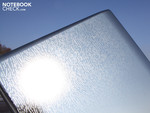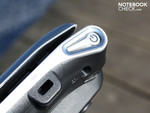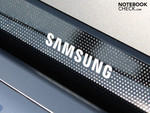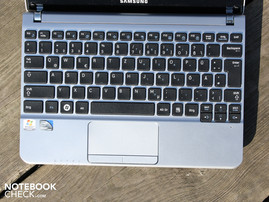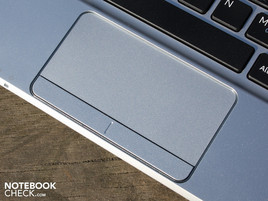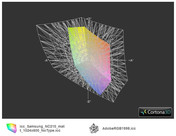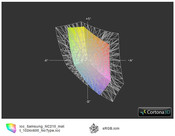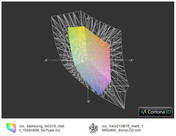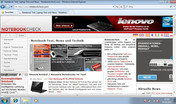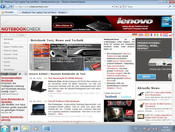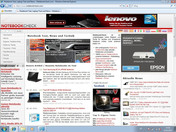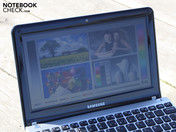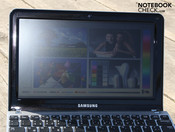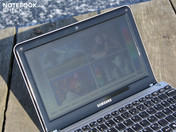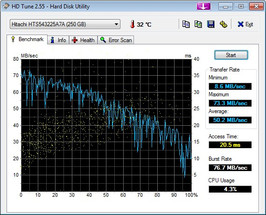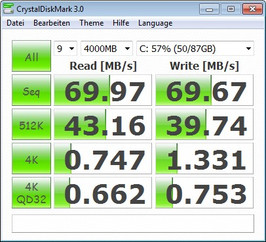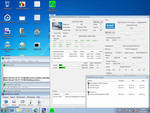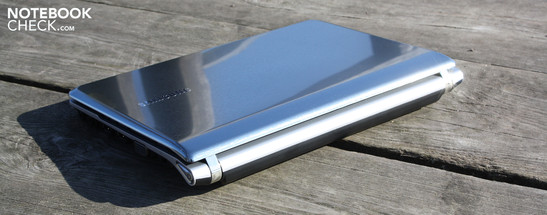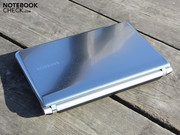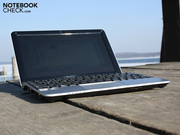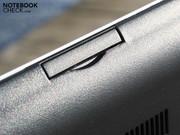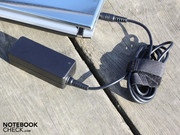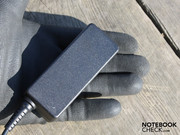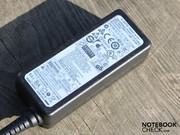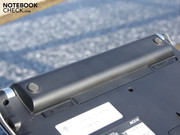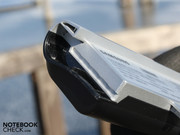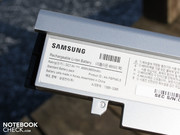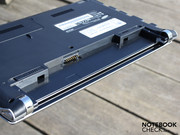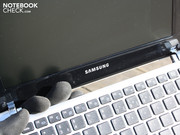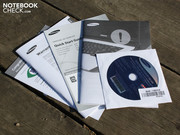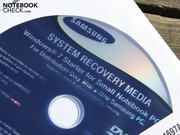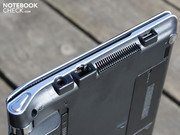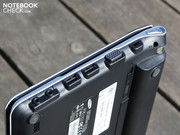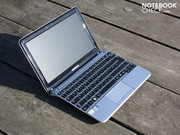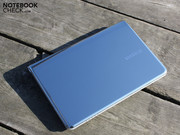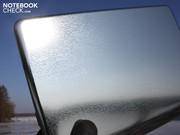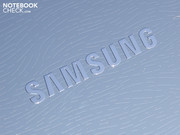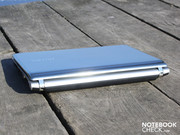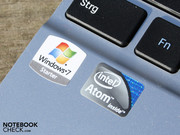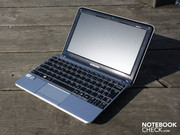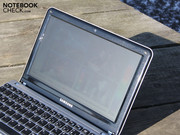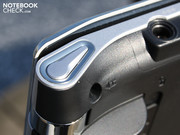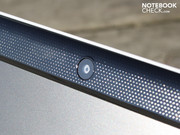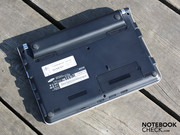Review Samsung NC210-A01DE Netbook

A number of small netbooks are found behind the Samsung label. The recently reviewed NC10-JP01DE and the N145-JP02DE are part of the infantry in the price war. Although they only fight with a single core Atom (N450/N455), they fling themselves at the enemy in vast numbers.
The cavalry, in the form of the NF310-A01DE or the present NC210-A01DE, is armed with two horse powers. These are the dual core netbooks of the Korean manufacturer. Does the future belong to them because they relentlessly charge past the infantry for revenge? After all, the Athlons and Fusions have caused losses in customer numbers.
We would like to take an objective look at the 10.1 inch Samsung N210-A01DE. Can this device meet the high mobility requirements of today? How does the manufacturer deal with the weak WSVGA resolution (1024x600), which only provides little room on the desktop? AMD Fusion or Intel Atom? This review answers all questions.
Case
The netbook appears in a straight-lined, angular but at the same time also rounded chassis. The corners are obviously rounded and the fairly thin lid is deeply sunken. The base unit is tapered to the front and has hard edges towards the work surface. The lid creates a contrast with its round edges and dotted bezel.
The wave shaped NF310 (shark design) form language has also unobtrusively found its way into this case. The base unit drops a by few degrees at the back just before the hinges. The lid provides the counter curve. On the whole, all of this makes a stylish and cutting-edge impression. The glossy chrome lid, which has an intensely reflective effect, additionally adds a bit of astronautic looks. It is a plastic and not an aluminum finish.
The only 1175 gram heavy plastic case has an acceptable, but not especially good, stability. We can noticeably twist the base unit with both hands and a bit of force. Pressure on the narrow wrist-rest produces an evident dent on the right. The base plate dents at the vent and on the right.
Component access is first possible after removing the entire base plate. Two screws are found underneath the front feet. Merely a small opening allows access to the single RAM slot (DDR3).
The lid can be opened to only 135 degrees and has a soft, coiling stop. The chrome-colored hinge covering is very pliable, which lessens the quality rating. The hinges fit loosely on the base unit, but are pulled so tight that both hands are needed for opening. In return, the display doesn't teeter in the train or during rough trips by car.
Connectivity
The NC210 includes the usual simplicity of netbooks in terms of interfaces. The visible ports are made up of three USB 2.0s, a cardreader (SD/MMC), a VGA socket (D sub), a RJ45 network interface and two jacks for headphone and microphone. The inconspicuous webcam in the display bezel can only take pictures in 640x480 pixels (0.3 MP).
Communication
In addition to WLAN draft n (Broadcom) and Bluetooth 3.0+HS, there is a Realtek Fast Ethernet controller in the case. The LAN controller does not support Gigabit Ethernet. Bluetooth 3.0 supports the latest standard. It should achieve transfer rates of 24 MB/s (high speed channel). The NC210 would have looked even better with built-in 3G. This would have created a portable machine for on the go in combination with a bright, matt display and long battery life.
Supplies
There's a new development in terms of software. The manufacturer again includes a recovery DVD. The user can nevertheless burn the system's entire status on according data carriers via Samsung Recovery Solution. Thus, the computer's initial personal setup would be saved.
As usual, Samsung installs a range of notebook tools. Many of these are quite useful in our opinion and improve working with the netbook. Among them: EasyMigration (migrating data), PhoneShare (sharing the internet connection with the mobile), Easy File Sharing (data access from other computers), Easy Network Manager (locating WLAN & Ethernet) and Update Plus (driver updates).
We found BatteryLife Extender and EasyResolution Manager pleasing. The former limits the maximum battery recharge to 80 percent, which extends the battery life but naturally reduces the battery runtime. The Resolution Manager interpolates the resolution and creates a somewhat more manageable 1024x768 from the native 1024x600 pixels.
Warranty
The manufacturer warranty adds up to 12 months. Warranty Plus is an extension of the standard warranty by one year. Price: about 50 euros.
Input Devices
Keyboard
The NC210 comes up with a fairly comfortable keyboard that exploits the maximum width up to the last millimeter. The keys have a medium key drop and a firm stroke over the entire surface. The only flaw is the unclear pressure point, which creates a too soft feedback. The key area doesn't yield anywhere. The keys have a fairly large gap between each other.
The small arrow keys, including the up / down keys, are allowed to protrude a bit into the wrist-rest. This prevents unintentional triggering of the page keys. The narrow and rather slippery wrist-rest doesn't provide a secure grip while typing, in particular for large hands. However, this is a typical flaw found in almost all netbooks. Overall, the typing feel is accurate (distance, layout), but suffers under the unclear pressure point.
Touchpad
The Elan mouse replacement has a pleasant, matt surface. The fingers glide fast and with clear friction over the pad. Fingerprints or greasy residues aren't left behind. The pad has an unmarked vertical and horizontal scroll bar. It is a typical multi-touch mouse pad that executes zooming or scrolling with two finger gestures. If you don't need the scroll bars and would rather have the entire pad available, you can disable the scroll bars in the Elan software.
The mouse key has a sufficient key drop on its outer sides (right and left), as well as a clear pressure point. However, if you click rather more towards the center of each key, you'll experience a stiff pressure point that requires a lot of force. The keys' cavity proves to be annoying because the operating thumb collides with the frontal frame. The submerged keys are suboptimal for fast usage.
Display
The NC210's low price demands its first victim. Although, the 10.1 inch display bids a matt surface as many customers want it, the native resolution is only 1024x600 pixels. This is the outmoded netbook standard. The screen in the sister model, NF310-A01, has a resolution of 1366x768 pixels in an equally matt surface at the same size. This provides for a better overview on websites or programs.
Samsung remedies this a bit with two interpolated (higher) resolution levels. The resolutions 1024x768 pixels or 1152x854 pixels can be enabled if desired. This is done with the EasyResolution Manager (can only be set to 1024x768 pixels) or directly via right mouse click and display resolution. Naturally, the picture suffers under distortions with such interpolations (e.g. a few Asus Eee PCs). Please see our screenshots.
The contrast of the undeterminable screen proves to be as so often bad: 134:1. Contrasts describe the proportional difference between white and black. Colors look pallid and everything but brilliant on the TFT. There is a vast difference between the NC210's color spectrum and the, for example, good yet not perfect screen in the Sony Vaio Z13B7E (t). However, this doesn't harm the netbook in our rating because image processing professionals will definitely not work on a 10.1 inch device, even if it had an extended color spectrum (AdobeRGB, sRGB).
| |||||||||||||||||||||||||
Brightness Distribution: 80 %
Center on Battery: 338 cd/m²
Contrast: 134:1 (Black: 2.53 cd/m²)
37.41% AdobeRGB 1998 (Argyll 3D)
54.4% sRGB (Argyll 3D)
36.17% Display P3 (Argyll 3D)
The matt LED display is called SuperBright by the manufacturer. It's true. The average brightness is grand 308 cd/m2. However, the illumination, viz. the even distribution of brightness, suffers. It is only 80%. Consequently, the darkest sectors only shine 80% as intense as the brightest ones. This isn't important for practical use, though. We don't see any bright-dark spots on a completely black or white background with the naked eye.
The high maximum brightness is exaggerated for indoor use. Users will dim the brightness to 100 up to 150 cd/m2 so that the eyes aren't unduly stressed. The high brightness is however vital for outdoor use. Corresponding to the low reflection display, we experience a good frontal and lateral view even in bright, direct sunlight. The picture of the frontal view shows how reflections due to sunlight are dispersed on the screen. Short: the Samsung NC210 has the perfect screen for the park, the beach or the balcony next summer.
The horizontal viewing angles are within standard in notebook comparison with about 50 degrees. Ghosting first turns up beyond that. However, inverting already begins at 15 degrees vertically. The very limited vertical viewing angles can be seen well on the darkroom picture. The result: when a second or even third viewer joins in, they will only see a suboptimal picture.
Performance
Samsung installs the dual core Atom N550 (2x1.5 GHz), which is on Intel's NM10 netbook chipset. Alike the single core CPUs, N450/N455, a GMA 3150 is incorporated in the processor. The graphic card is thus included in the TDP of 8.5 watts. N450/N455 (5.5 watts) have a three watt lower TDP.
The N550 has a dedicated DDR3 memory controller (standard starting with N455), which is why a one GB DDR3 RAM is inserted. This slot can be accessed via a small cover on the bottom. The GMA 3150 (core rate: 200 MHz, DirectX 9c) isn't apt for gaming and also can't unburden the processor in calculating via hardware support. A 2.5 inch hard disk from Hitachi (HTS543225A7A) with a capacity of 250 GB and 5400 rpm also belong to the configuration.
Alike the single cores, the Atom N550 supports Hyper Threading. Thus, the dual core can compute with a total of four threads. A slight increase in multitasking operations is noted, as a comparison with the single core Atom N455/N450 shows.
The N550 achieves 1320 points in the multi core benchmark, Cinebench R10 32 bit. A N455 reaches 840 (@ 1.66 GHz, Acer One 533-13Drr) up to 888 points (@ 1.7 GHz, Asus Eee PC 1016P). An N450 presents 938 points (@ 1.66 GHz, Asus Eee PC 1008P). The single cores are therefore inferior by about 40% (single core average rates).
Dual core beats single core - that's not surprising. But what about the AMD processor competition, as it currently enters the market as Fusion, among others (Acer Aspire One 522, Toshiba NB550D)? The AMD C-50 (9 watts, 2x1.0 GHz) is 14% slower in Cinebench R10 Multi. An Athlon K125 (1x1.7 GHz, Acer Aspire One 521) is 12% slower due to its single core in multi thread calculating
| PCMark 05 Standard | 1429 points | |
| PCMark Vantage Result | 1389 points | |
Help | ||
The dual core N550 excels its single core colleagues easily in pure multi thread computing performance. Thus, it slightly surpasses the AMD Fusion and Athlon competition. But is the overall performance of a N550 system really superior? We determined the answer with PCMark Vantage and it is: No. The system benchmark finishes with 1389 points. The HDD sub score of 3078 has a share in this.
A Fusion C-50 (Toshiba NB550D) achieves 1438 points. The APU's small advantage is achieved by the Radeon HD 6250 graphics card. It is considerably stronger than the N550's Intel GMA 3150 due to 80 shaders and UVD3 video processor. When Nvidia's ion2 comes into play (Asus Eee PC 1015PN), this advantage is naturally lost again. In any case, the AMD netbooks are on par and they are usually less expensive. Another advantage of the AMD solution is a HDMI out.
The subjective work speed of Samsung's NC210 is smoother and thus more pleasant than with all Atom single core netbooks (about 1200 PCMark Vantage points) that we have had in review.
| 3DMark 2001SE Standard | 2286 points | |
| 3DMark 03 Standard | 640 points | |
| 3DMark 05 Standard | 280 points | |
| 3DMark 06 Standard Score | 142 points | |
Help | ||
The 250 GB Hitachi hard disk works with a rotation speed of 5400 rpm. HDTune determined an average rate of 50 megabytes per second (sequential read). This throughput is considerably below the midfield of comparable 2.5 inch hard disks in netbooks and notebooks (about 65 MB/s). The access rate of 20.5 milliseconds is also very slow. For example, fast 5400 rpm HDD achieve 16.9 ms (Dell Mini 1012).
If you intend to upgrade the 250 GB, you won't find a maintenance cover. Since the case's bottom is a tray, the keyboard as well as the cover plate has to be removed.
Emissions
System Noise
We are dealing with a very quiet 10.1 incher. We aren't disturbed by the fan while surfing on the web or writing emails: 31.4 dB(A). The fan runs along quietly the whole time. When Samsung's Silent Mode (FN+F8) is activated, the fan turns of permanently and merely the quiet noise from the HDD remains measurable with 30.7 dB(A).
The hard disk is heard sporadically by a high pitched clacking from the read-write heads: 32.3 dB(A). The NC210 is only marginally louder under continuous CPU load (stress test). The processor and graphics stress test only increases the fan noise to 34.9 dB(A). We hear a high-pitched, constant noise.
Silent Mode turns the fan off permanently. It is first reactivated when the processor is put under consistent stress, or the temperature gets too high for other reasons. The maximum noise can even be reduced with it. When Silent Mode is enabled in the stress test, the noise level sinks to 30.8 dB(A) and is paid for with CPU performance. The fan remains deactivated for a while. Silent Mode limits the Atom N4550's clock rate to 997 MHz.
Noise level
| Idle |
| 30.7 / 31.4 / 31.4 dB(A) |
| HDD |
| 32.3 dB(A) |
| Load |
| 34.9 / 34.9 dB(A) |
 | ||
30 dB silent 40 dB(A) audible 50 dB(A) loud |
||
min: | ||
Temperature
The waste heat stays low in every state (idle, stress). The bottom's average temperature is 29 degrees Celsius while surfing on the internet and word processing tasks. The wrist-rest area stays cool with a maximum of 27 degrees.
Load induced by Prime95 and 3DMark06 only increases the temperatures on the top and bottom slightly (in contrast to idle). The base plate now reports 30 instead of 29 degrees. Idle and load temperatures only differ so marginally on average because warm waste air accumulates in the case in Silent Mode, so disabled fan. The fan enabled under load discharges this air and the newly developed waste air out of the case, which results in even cooler areas in some areas.
(+) The maximum temperature on the upper side is 29.3 °C / 85 F, compared to the average of 33.1 °C / 92 F, ranging from 21.6 to 53.2 °C for the class Netbook.
(+) The bottom heats up to a maximum of 38 °C / 100 F, compared to the average of 36.6 °C / 98 F
(+) In idle usage, the average temperature for the upper side is 25 °C / 77 F, compared to the device average of 29.8 °C / 86 F.
(+) The palmrests and touchpad are cooler than skin temperature with a maximum of 28 °C / 82.4 F and are therefore cool to the touch.
(±) The average temperature of the palmrest area of similar devices was 29.3 °C / 84.7 F (+1.3 °C / 2.3 F).
Speakers
The speaker sound is adequate, but remote from being good. The two little stereo membranes are located in the base plate's front area. They emit the sound towards the tabletop, which reflects the sound waves. In view of the netbook size the volume is fairly loud. In terms of sound, the high ranges and, to a part, the midranges are emphasized and consequently aren't differentiated. There aren't any basses, since a subwoofer hasn't been installed and because of the small speakers. External speakers or headphones can be connected to the headphone out. The high level appears static-free in the audio test.
Battery Life
Samsung states a battery life of 15 hours with the 6 cell battery. Great, as exactly this model is in our test device and allows us to check the amount of truth in this specification. The determined idle runtime of 10:40 hours can't verify this declaration, even with the lowest possible power consumption. The idle runtime with lowest brightness and disabled wireless modules isn't a real indication for practical use, anyway.
The WLAN test of 5:55 hours is very close to practical use. The Aspire One 533 lasted for just as long (N455 single core, 5:49 hours, 49 watts). The N450 sister model in an Asus Eee PC 1001P achieved six hours (48 watts). We realize: two cores don't have an impact on the battery life with the same battery capacity. 3:12 hours pass before we can start the next surf session (charge time).
The battery life is a bit shorter when playing a movie from the hard disk (low quality, AVI file, not H.264). The 10.1 incher lasts 5:42 hours. The TFT's brightness was set to 100 cd/m2, wireless modules were disabled. The runtime sinks to a good 4:49 hours under load (BatteryEater's Classic, wireless enabled, maximum brightness).
However, the latest AMD Fusion technology, as in the Toshiba NB550D-10H, can excel the NC210's runtime. Idle, it purrs along for 13:37 hours with a higher capacity of 61 watt hours. The AMD competition even accomplishes 8:43 hours in the WLAN test (load: 4:19). Of course, the difference in capacity makes the comparison unfair, but it proves that an Atom N550 isn't the non plus ultra in the netbook world.
The idle power consumption is 7.5 watts (minimum brightness, energy saving mode, wireless disabled). A N450 system is more frugal with 6.2 watts (Samsung N220). But the same dual core N550 can manage with 4.3 watts in another netbook (Acer Aspire One D255). Note: we measure the system's power consumption, not the CPU's.
The maximum power consumption of 15 watts completely exhausts the TDP of 8.5 watts (Prime95 on all four threads + 3DMark06). N450/N455 systems consume 12.5 (Eee PC 1001P), respectively 13.6 watts Aspire One 533). Our test device's high TFT brightness increases the power consumption only marginally in comparison to other models. The 40 watt adapter only weighs 167 grams and can easily manage the maximum power consumption plus charging current. It only heats up to 30 degrees under load.
| Off / Standby | |
| Idle | |
| Load |
|
Key:
min: | |
Verdict
Samsung packs an interesting 10.1 incher in a slightly feeble plastic case and can score well in all fields relevant for mobility. The big strength is the extremely bright and matt WSVGA screen: 207 cd/m2. The low resolution can at least be interpolated to 1152x864 pixels.
The battery life of six hours and the low weight of only 1175 grams (despite the 6 cell battery) speak for a high mobility. In addition, there is the Silent Mode and a system noise that is almost inaudible – if the fan even rotates at all. The same applies to waste heat because the case always remains cool.
After so much praise, "only" a GOOD? The partly bendable plastic case and the spongy hinges narrow the construction's overall impression. The touchpad suffers under its deeply submerged keys and the keyboard under its soft pressure point.
As the majority of netbooks, the NC210 also loses points with the few interfaces and the non-existing 3D performance. The Atom dual core calculates a bit faster than a single core Atom and lets the system run "smoother". But the N550 is a small fry in comparison to other notebook CPUs. These drawbacks are only considered to a fraction in the rating.




